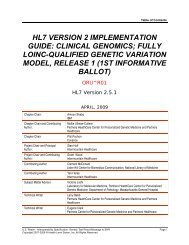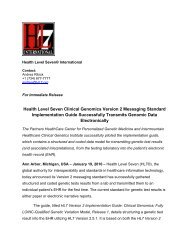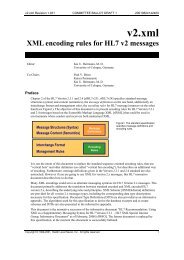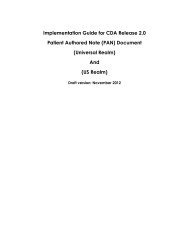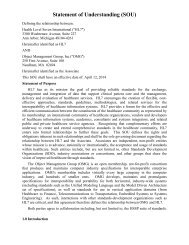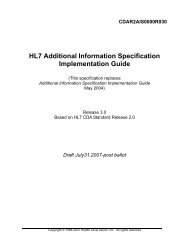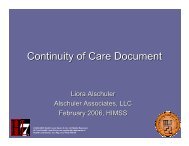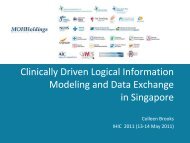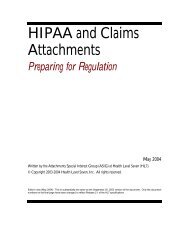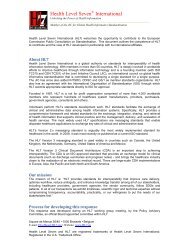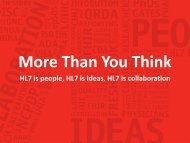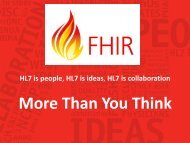Templates and Archetypes GF.fm - HL7
Templates and Archetypes GF.fm - HL7
Templates and Archetypes GF.fm - HL7
Create successful ePaper yourself
Turn your PDF publications into a flip-book with our unique Google optimized e-Paper software.
tion order in hospital or primary care are semantically equivalent <strong>and</strong> will oftencontinue to be relevant after transfer from one care setting to another.It is apparent that there are two levels that the recordings are specialised <strong>and</strong> extended- organisation <strong>and</strong> specific entries <strong>and</strong> values. I will consider each of these separately.Organisational modelsThere are shared models that apply across different settings <strong>and</strong> relate to record organisation.Examples are the recording of a clinician-patient interaction in a traditionalmanner - history, physical examination, diagnosis, management etc <strong>and</strong> a problem orientedapproach where the SOAP model might be invoked multiple times in one recordunder a different problem heading.Figure 3: Traditional <strong>and</strong> problem oriented organisationHistoryHeadacheToothachePhysical examOptic Fundi normalSwelling under R4 molarDiagnosesTooth abcessToothacheS: Painful tooth on RO: Swelling under R4 molarA: Tooth abcessHeadacheS: Overnight - poor sleepO: Optic fundi normalA: Secondary to toothacheThe organisation of a diabetic care message <strong>and</strong> a CDA cardiology report may vary indifferent settings - although, with increasing communication, alignment will be helpful.However, it is likely that organisational models will be st<strong>and</strong>ardised in a particularlocality or institution, <strong>and</strong> that this might - with time - extend to a wider realm.If the information model is sufficiently generic then there is a need for an artefact toexpress these ‘organisational’ constraints, recognising that while they express someknowledge, the meaning of the ‘archetyped’ information that these models ‘organise’is not altered. Such organisational models may well (<strong>and</strong> even perhaps will usually)restrict the archetyped models that may sensibly appear at this point in the EHR. Considerthe “O:” in the problem oriented example above. It would be sensible to limitwhat would usually appear here to observations of the patient. We propose that theseconstraints are called ‘organisational’ models - organisational ‘archetypes’.The features of ‘organisational’ archetypes are:• The need for these models is based on use-cases – local or more general - butstill has strong links with the knowledge base. Thus a section called ‘physicalexamination’ <strong>and</strong> ‘examination of the abdomen’ can be known to be related.• There need be no restriction on the number of these artefacts but their relationshipsshould be understood• These models carry no primary semantic content - but the efficiency of humans<strong>and</strong> machines to query or read the meaning of the finer grain content would bediminished• Re-use of these models is encouraged – for aiding information navigation byusers• There is no need for registration of these models for semantic interoperability• These models may not be present in the ontology



